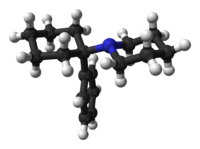PCP (drug)
 |
|
 |
|
| Clinical data | |
|---|---|
| AHFS/Drugs.com | phencyclidine |
| Addiction liability |
Moderate |
| Routes of administration |
Injection, insufflation, smoking, oral |
| ATC code |
|
| Legal status | |
| Legal status |
|
| Pharmacokinetic data | |
| Onset of action | 2 to 60 min |
| Biological half-life | 7–46 hours |
| Duration of action | 6 to 48 hours |
| Identifiers | |
|
|
| CAS Number | |
| PubChem CID | |
| IUPHAR/BPS | |
| DrugBank | |
| ChemSpider | |
| UNII | |
| KEGG | |
| ChEBI | |
| ChEMBL | |
| ECHA InfoCard | 100.150.427 |
| Chemical and physical data | |
| Formula | C17H25N |
| Molar mass | 243.387 g/mol |
| 3D model (Jmol) | |
|
|
|
|
| See also: data page | |
|
|
|
Phencyclidine (PCP), also known as angel dust and Sernyl among others, is a dissociative drug. PCP was brought to market in the 1950s as an anesthetic pharmaceutical drug but was taken off the market in 1965 due to the high prevalence of dissociative hallucinogenic side effects. Moreover, the discovery of ketamine by Parke-Davis researchers was thought to represent a better-tolerated alternative for use as an anesthetic medication. Since this time a number of synthetic derivatives of PCP have been sold as dissociative drugs for recreational and non-medical use.
In chemical structure, PCP is a member of the arylcyclohexylamine class, and, in pharmacology, it is a member of the family of dissociative anesthetics. PCP works primarily as an NMDA receptor antagonist. As an addictive drug, PCP is associated with compulsive abuse.
As a recreational drug, PCP may be ingested orally, smoked, insufflated or injected.
PCP began to emerge as a recreational drug in major cities in the United States in 1967. In 1978, People magazine and Mike Wallace of 60 Minutes called PCP the country's "number one" drug problem. Although recreational use of the drug had always been relatively low, it began declining significantly in the 1980s. In surveys, the number of high school students admitting to trying PCP at least once fell from 13% in 1979 to less than 3% in 1990.
...
Wikipedia
